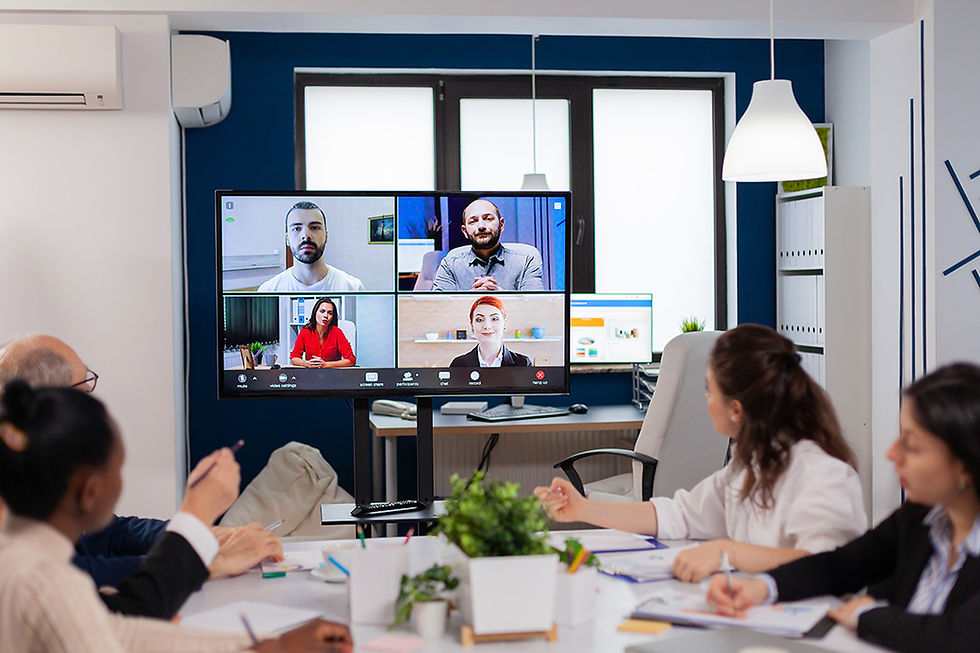The Evolution of AV Roles in the Event Industry
- joyce388
- Oct 15
- 3 min read

What do a 1940s spotlight operator and today’s hybrid event technician have in common? More than you’d think. While technology has changed the game, one thing remains the same: great events rely on the people behind the gear just as much as the gear itself.
At Corporate AV, LLC, we’ve seen firsthand how audio-visual roles have evolved—and how each new advancement opens the door to more ambitious, immersive, and inclusive events. Whether you're planning a company-wide summit, investor meeting, or hybrid product launch, understanding the evolution of AV roles gives you a better idea of what kind of team you need to pull it off.
Let’s take a look back… and then forward.
The Early Days: Lights, Camera… That’s It
Back in the mid-20th century, “AV” was simple—but still essential. Events at hotels or town halls might involve a 16mm film projector, a microphone, and a spotlight. Technicians were few and focused: one person ran the projector, another handled lighting cues (usually manually), and if there was sound reinforcement, it was usually someone with a music background setting up rudimentary PA systems.
Roles were basic because the technology was basic. But even then, a smooth presentation or meeting hinged on the skills of the AV crew. If the film jammed or the mic squealed, the entire experience was disrupted.
The Rise of the Slide Deck: 1970s–1990s
The overhead projector changed everything. Suddenly, corporate trainers, educators, and keynote speakers had visuals—and AV teams had more moving parts to manage. Slide projectors, multi-mic setups, and lighting rigs became standard for conferences and conventions.
This era also introduced the “AV tech” as a staple crew member for corporate events. These professionals were tasked with managing cabling, testing microphones, setting up projection screens, and operating equipment during the event. The roles were still largely reactive—fixing problems as they happened.
The Digital Revolution: 2000s
The shift to digital presentations (hello, PowerPoint!) and computer-based playback systems expanded AV’s reach. Now we weren’t just talking about displaying slides—we were embedding video, triggering audio cues, even running motion graphics.
AV roles became more specialized. You might have:
● A video switcher controlling which feed showed on screen.
● A graphics operator queuing up speaker presentations.
● A sound engineer managing wireless mic frequencies and multi-channel mixing.
● A lighting designer crafting the perfect mood for branding or emotional impact.
As corporate events grew in size and scale, so did the AV crews. Instead of a single tech, you needed a team—and not just people who knew how to plug things in, but professionals who could interpret run-of-show cues, anticipate transitions, and think on their feet.
The Streaming Shift: 2010s
By the 2010s, streaming wasn’t just for YouTube—it was for your quarterly all-hands, your shareholder updates, and your global product announcements. The AV world responded by adding roles like:
Streaming engineers who manage encoding, platform integration, and live switching.
Virtual stage managers who cue remote presenters and troubleshoot connection issues.
Onsite broadcast producers who blend the in-person and online experience seamlessly.
Suddenly, AV was no longer a behind-the-scenes function. It became the showrunner.
Today’s Landscape: Hybrid Everything
Now, in the 2020s, every event is potentially global. A panel in San Francisco can include speakers in New York, London, and Tokyo—and be broadcast live to an audience of thousands.
That’s exciting. But it also means every AV role carries more weight.
Today’s corporate event might involve:
Camera operators managing multi-cam coverage for in-person and remote feeds.
Technical directors coordinate between the in-room crew and streaming platforms.
Interactive tech leads overseeing live polls, Q&A tools, and audience chat moderation.
IT-savvy AV engineers ensure network bandwidth and cybersecurity protocols are up to standard.
And the equipment? It’s not just cables and microphones. We’re talking LED walls, virtual sets, remote presenter kits, wireless intercom systems, green screen rigs, and ultra-quiet PTZ cameras.
Why Your AV Team Matters More Than Ever
With so many roles and responsibilities at play, your AV crew isn’t just a support function—they’re a core part of the event’s success. Good lighting isn’t just about visibility; it sets the mood. Smooth audio isn’t just about clarity; it builds trust. A clean stream doesn’t just look professional; it signals your brand is polished and prepared.
That’s why we always recommend working with a seasoned, full-service team like Corporate AV, LLC.
When you rent your gear and your crew from the same trusted source, everything works better:
• We prep, test, and transport all the gear you need.
• We assemble a crew of experienced pros tailored to your event type.
• We troubleshoot before the audience ever walks in—or logs on.
• We understand what’s at stake for your brand and your message.
Ready to Evolve with the Times?
Technology will keep advancing. Roles will keep expanding. But is there a need for a knowledgeable, adaptable AV team? That’s not going anywhere.
Let Corporate AV, LLC help you put together a show-ready crew that can handle today’s demands with yesterday’s dependability. Whether you need an all-in-one hybrid event package or just expert guidance on what to rent and who to hire, we’re here to make your event exceptional.








Comments